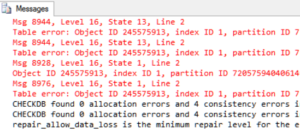Podcast Episode – The Long Awaited Index Episode
For a couple of months we have had requests on the SQL Data Partners Podcast to do an episode on indexing. It is my pleasure… Read More »Podcast Episode – The Long Awaited Index Episode
For a couple of months we have had requests on the SQL Data Partners Podcast to do an episode on indexing. It is my pleasure… Read More »Podcast Episode – The Long Awaited Index Episode
Please join Carlos and I for our first Database Corruption webcast on May 3rd. I have teamed up with Carlos and we will be presenting some thoughts on database corruption with an extended Q&A session.
One important detail is we will be taking questions and answering them live on the webcast so this will be a great way to engage and ask a follow up if needed. I think you will love this format–way better than soaking up 50 minutes of boring and then calling it quits.
The webcast will cover these major topics.
1) Preparing for database corruption and taking the right steps to ensure you can recover
2) A few lessons learned about our experience with database corruption
This weeks session will cover:

The best DR plan still needs to account for corruption.
TL;DR summary: Don’t do it. Stop reading here if you want, but just don’t do it.
This post refers to shrinking your database files (mdf, or ndf files), not shrinking the log file. The log file is a completely different conversation, however shrink database does shrink the log file.
Not shrinking your database is one of the more counter intuitive things out there. You might think that a smaller database is a good thing, however there are some negative side effect if you shrink your database regularly, or have the autoshrink option enabled. Side effects of shrinking your database include:
Read More »DBCC ShrinkDatabase – I want to shrink my database.